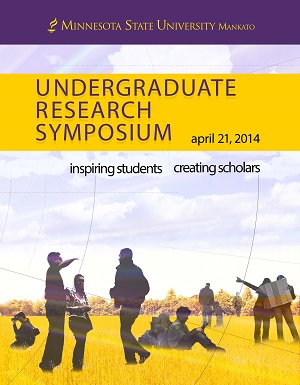Effects of Ultraviolet Radiation on the Brown Midrib Mutation in Sorghum Bicolor and Zea
Location
CSU Ballroom
Start Date
21-4-2014 10:00 AM
End Date
21-4-2014 11:30 AM
Student's Major
Biological Sciences
Student's College
Science, Engineering and Technology
Mentor's Name
Christopher Ruhland
Mentor's Email Address
christopher.ruhland@mnsu.edu
Mentor's Department
Biological Sciences
Mentor's College
Science, Engineering and Technology
Description
Examining plant responses to ultraviolet radiation (UV) under realistic spectral regimes has relied upon supplementing ambient UV using lamps or reducing UV using filters. Responses to sub-ambient UV tend to be more pronounced than those under elevated UV. However, few studies have examined these responses in greenhouses because most cladding absorbs UV. A new greenhouse polycarbonate material has been introduced that transmits >77% of ambient UV. We examined how UV influenced production of UV-screening compounds, chlorophyll fluorescence, growth, and cell wall constituents in the Brown Midrib (BMR) mutation in Sorghum bicolor (sorghum) and Zea mays (corn). These BMR varieties are an ideal forage feedstock due to lowered expression of cinnamyl alcohol dehydrogenase and caffeic O-methyltransferase enzymes in lignin synthesis. Plants were grown in a UV-transparent greenhouse under filters that either attenuate (mylar) or transmit (aclar) UV. We measured epidermal screening of UV with a modulated fluorometer and the quantum yield of photosystem II (ΦPSII) and the variable to maximal fluorescence ratio (Fv/Fm) with a chlorophyll fluorometer. Plants under aclar had 22-23% greater epidermal shielding and 35-54% more UV-absorbing compounds than those under mylar. There were few UV effects on ΦPSII, Fv/Fm and growth of either species with the exception of plant height in sorghum. Effects on cell wall constituents were subtle, with cellulose concentrations being 2.5% greater in corn under mylar and lignin concentrations being 1% greater in sorghum under aclar. It appears that BMR sorghum and corn are responsive to UV which could influence their performance in agricultural settings.
Effects of Ultraviolet Radiation on the Brown Midrib Mutation in Sorghum Bicolor and Zea
CSU Ballroom
Examining plant responses to ultraviolet radiation (UV) under realistic spectral regimes has relied upon supplementing ambient UV using lamps or reducing UV using filters. Responses to sub-ambient UV tend to be more pronounced than those under elevated UV. However, few studies have examined these responses in greenhouses because most cladding absorbs UV. A new greenhouse polycarbonate material has been introduced that transmits >77% of ambient UV. We examined how UV influenced production of UV-screening compounds, chlorophyll fluorescence, growth, and cell wall constituents in the Brown Midrib (BMR) mutation in Sorghum bicolor (sorghum) and Zea mays (corn). These BMR varieties are an ideal forage feedstock due to lowered expression of cinnamyl alcohol dehydrogenase and caffeic O-methyltransferase enzymes in lignin synthesis. Plants were grown in a UV-transparent greenhouse under filters that either attenuate (mylar) or transmit (aclar) UV. We measured epidermal screening of UV with a modulated fluorometer and the quantum yield of photosystem II (ΦPSII) and the variable to maximal fluorescence ratio (Fv/Fm) with a chlorophyll fluorometer. Plants under aclar had 22-23% greater epidermal shielding and 35-54% more UV-absorbing compounds than those under mylar. There were few UV effects on ΦPSII, Fv/Fm and growth of either species with the exception of plant height in sorghum. Effects on cell wall constituents were subtle, with cellulose concentrations being 2.5% greater in corn under mylar and lignin concentrations being 1% greater in sorghum under aclar. It appears that BMR sorghum and corn are responsive to UV which could influence their performance in agricultural settings.
Recommended Citation
Eatwell, Maegan. "Effects of Ultraviolet Radiation on the Brown Midrib Mutation in Sorghum Bicolor and Zea." Undergraduate Research Symposium, Mankato, MN, April 21, 2014.
https://cornerstone.lib.mnsu.edu/urs/2014/poster_session_A/10



